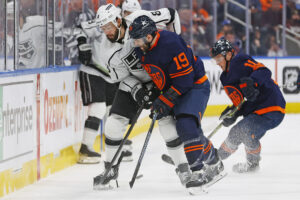Murmurs around the 2020 NHL Draft are never-ending now that the Draft is no longer taking place in June. Recent focus has turned to potential late-round steals, a category that Stephen Halliday fits perfectly into. The 17-year-old is projected as a third-round pick or later heading into the Draft but his staggering size, mixed with great shooting and offence, has drawn the eye of many. This includes draft aficionado Steven Ellis, who called Halliday a, “sleeper I truly believe will prove people wrong… He’s a project player that I fully believe will pay dividends.”
But despite his increasingly positive perception by some of the world’s best prospect minds, Halliday’s true potefntial is hard to decipher. Ultimately, the winger has ‘boom-or-bust‘ potential in this year’s draft. He’ll either be a star or flounder in professional hockey.
Figuring Out Stephen Halliday and His Potential
Good News
Stephen Halliday is big. Really big. The 17-year-old already stands at 6-foot-4 and weighs in at 220 pounds (193 cm, 100 kg). But his towering over nearly everyone else makes him seem that much bigger. His size and corresponding strength is easily his best asset. It allows him to thwart off next to any other player in the USHL.
But watching Halliday play, it doesn’t seem like he’s well aware of the gift that is his size. Instead, his preferred style of play more similarly resembles that of a small-and-speedy forward. Halliday absolutely loves having the puck on his stick. And not to the detriment of his team. With the puck in his possession, Halliday is terrific at driving the play through the neutral zone and setting up in the offensive end. Largely thanks to his size, he has a terrific ability to wheel the puck behind the net and set up any sort of offensive system.
After driving into the zone, Halliday has terrific passing and a booming wrist shot, largely thanks to his strength. This makes him an even stronger offensive asset, allowing him to fit into really any slot in the O-zone.
Bad News
The Offence
But his offence, clearly, isn’t perfect; hence his mid-round projection. Halliday’s biggest issue in the offensive end is his tunnel vision, which has a tendency to limit his efficiency. But that’s far from the biggest worry in the O-zone. Halliday’s woes mostly come from simply being a product of his situation. With the Central Illinois Flying Aces, who Stephan Halliday played for in the 2018-19 season, he was held to almost only a net-front-presence role. He was given very little opportunity to shoot or work the zone, as a playmaker of his ability should be able to do.
Instead, the Flying Aces simply held the winger to the – really outdated – net-front position, in the same vein as players like David Backes served in the mid-2010s. This simply isn’t how Halliday should be used and it showed in his stats. That year, Halliday tallied 34 points in 55 games; an admirable tally but a bit underwhelming for the man that was coming off of a first-overall selection in the 2018 USHL Draft.
Move to Dubuque
Many have chalked the slightly-disappointing point totals to Halliday being a rookie and finding his footing in the league. While this is surely a factor, his complete misuse in Central Illinois is by far the overwhelming component to his under-40 point totals. He proved that this season. After the CI Flying Aces folded, Halliday found himself on the Dubuque Fighting Saints, a much stronger and more offensively-focused team.
With the new logo on his chest, Halliday was given plenty more chances to handle the puck and shoot. In fact, despite playing in nine fewer games this year, Halliday managed 13 more shots; or increasing his per-game average by nearly a whole shot a game. While this is an admittedly underwhelming tally, it moved Halliday from one of the league’s lesser-shooters to a well-above-average shooter. In fact, he ranked 52nd in the league, out of 260 players. While he was still confined to a less-than-desirable role, the added trust surmounted in Halliday scoring 13 goals and 38 points in 46 games, a 45-point pace. This is a notable step up from his rookie season totals, largely thanks to the added trust that the new team gave him in the offensive end.
The Defence
While Stephen Halliday has been subject to his team’s misuse in the offensive end, his woes on defence fall entirely on his shoulders. Despite towering over much of the league, Halliday can seem very timid in his own zone. He very often seemingly had an aversion to throwing the body around or going into the corners of the zone. In fact, he often didn’t move much at all. Halliday remained perched in his own end for the majority of many games.
This again has improved a bit as he entered his sophomore season. But it’s not likely to notably improve for a bit. That’s simply because, like so many young big men, Halliday’s skating isn’t great. He manages to have admirable peak-speed given his size but his agility definitely leaves something to be desired. This affects every aspect of his game. His reactions in the D-zone are fairly slow because of it, forcing Halliday to retreat to a courtesy role in anything defensive-related.
This poor skating also affects what is one of his best traits, his play-driving, given his first step’s general leisurely pace. While not damning, and a common negative in players Halliday’s size, this issue is still incredibly noticeable when watching him play.
What This Means
But the poor skating can – and surely will – be solved as Halliday continues his career. As will the tunnel visioning in the offensive end and the fairly lackadaisical defensive zone performances.
What Halliday has is great size and strength, something that paves the way to a powerful and accurate shot. His awareness in the offensive end, matched with great passing, is also terrific. It’s a great package, one that’s very similar to that of players like Tage Thompson when he was Halliday’s age, although there are noticeable differences.
Stephen Halliday is a Boom or Bust
Still, it’s easy to think Halliday could truly soar in a professional environment. He’ll surely get drafted. If his new team does the right thing and doesn’t confine him to the stereotypical “big man” role that he’s been unfortunate enough to be stuck in in the USHL, Halliday could explode into a great offensive asset. Even a glimmer of a more appropriate role this season saw Halliday perform much better than he did in his rookie year. A team finding Halliday’s perfect groove could result in a big-man with the potency of a small offensive-dynamo. His ceiling is as a top-nine lock, at least, with promising goal-scoring not far off either.
But his success is going to be completely reliant on his team’s understanding that, despite his staggering size, his style is incredibly unique. As surely any NHL fan will testify to, many teams aren’t very keen on going incredibly in-depth on their mid-round draftees. Trusting any team to not post Halliday in front of the net seems like wishful thinking. But at the same time, limiting Halliday to such a stereotypical role is clearly wasting so much potential.
This reliance is what makes Halliday one of the greatest ‘boom or bust’ candidates in this year’s draft. He has enough raw talent to easily make him an NHL mainstay but only if things go the right way. If not, Halliday’s NHL career could be a steep uphill battle, with his size being his only defiant trait. Whoever lands him with their mid-round pick has plenty of work ahead of them but the payoff will surely be an incredibly talented and incredibly unique winger that could, in the most hopeful of settings, revolutionize the big-man persona.






